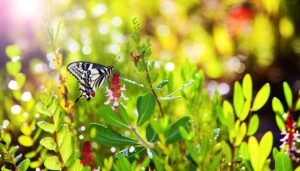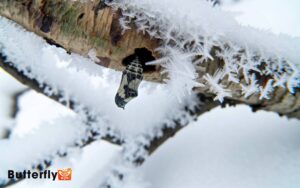Female Eastern Tiger Swallowtail Butterfly: Characteristics!
The female Eastern Tiger Swallowtail Butterfly (Papilio glaucus) exhibits sexual dimorphism with a larger wingspan, ranging from 7.9 to 14 cm.
Her forewings feature striking black and yellow stripes, while dark morphs provide camouflage and mimicry advantages. Found across the eastern US, she prefers deciduous forests and riparian zones.
Lifecycle stages include eggs, larvae, pupae, and adults, with host plants like tulip trees and wild cherry being essential.
Predators include birds; however, she employs mimicry and evasive flight for defense. This fascinating lepidopteran has much more intricate details waiting to be uncovered.

Key Takeaways
Physical Characteristics
The female Eastern Tiger Swallowtail butterfly exhibits striking sexual dimorphism, characterized by its larger size and varying color morphs compared to the male.
With a wingspan ranging from 86 to 115 millimeters, the female surpasses the male, whose wingspan averages around 76 to 100 millimeters.
The forewings display distinct black and yellow stripes, contributing to its distinctive appearance. The hindwings feature elongated tails, extending approximately 4 to 6 millimeters.
Additionally, females possess a robust thorax and abdomen, facilitating egg production and dispersal.
The antennae are club-shaped, enhancing sensory perception. The female’s legs, equipped with tarsal claws, enable efficient grasping of host plants during oviposition.
These physical characteristics underscore the adaptability and evolutionary success of the female Eastern Tiger Swallowtail.
Color Variations
Among the most fascinating aspects of the female Eastern Tiger Swallowtail butterfly is its remarkable color variations, which include yellow and dark morphs, each contributing to its survival and reproductive success.
The yellow morph features vibrant yellow wings with black tiger stripes, while the dark morph exhibits mainly black wings with subtle blue and orange hues.
These variations serve adaptive functions:
- Camouflage: Dark morphs blend into shaded forested environments, evading predators.
- Mimicry: They resemble the toxic Pipevine Swallowtail, deterring predation.
- Thermoregulation: Darker morphs absorb more heat, aiding in cooler climates.
- Mate Attraction: Bright yellow morphs are more visible, enhancing mating opportunities.
These color variations demonstrate the species’ evolutionary adaptability and ecological significance.
Geographic Range
The female Eastern Tiger Swallowtail butterfly (Papilio glaucus) mainly inhabits deciduous forests and adjacent meadows across the eastern United States, ranging from the Great Plains to the Atlantic coast.
Observations indicate seasonal migration patterns, with individuals moving northward during warmer months and retreating southward as temperatures drop.
Precise tracking has recorded their presence from as far north as southern Canada to as far south as Florida and the Gulf Coast.
Native Habitat Locations
Most commonly found in the eastern United States, the female Eastern Tiger Swallowtail butterfly inhabits deciduous forests, woodlands, and river valleys.
This species thrives in areas where its primary host plants, such as wild cherry and tulip trees, are abundant. Detailed observations reveal that these habitats provide the necessary resources for their entire life cycle.
Key habitat features include:
- Deciduous Forests: Rich in broadleaf trees, offering ample food sources.
- Woodlands: Less dense than forests, providing sunny spots for basking.
- River Valleys: Moist environments with diverse plant species.
- Suburban Gardens: Human-modified areas with suitable nectar plants.
These varied habitats support the butterfly’s needs for nourishment, reproduction, and shelter, ensuring their survival and proliferation in the eastern U.S.
Migration Patterns Observed
Researchers have observed that female Eastern Tiger Swallowtail butterflies exhibit limited migratory behavior, primarily expanding their range through generational dispersal within the eastern United States.
This species, Papilio glaucus, typically inhabits regions from the Gulf Coast to southern Canada, avoiding the far western states. They prefer deciduous forests and riparian corridors, utilizing host plants like tulip trees and wild cherry.
Female butterflies lay eggs on host plants, with larvae exhibiting a range of phenotypic adaptations to local environments. Their dispersal patterns are influenced by climatic conditions, availability of host plants, and predation pressures.
Rather than long-distance migration, these butterflies exhibit a gradual range expansion, contributing to their adaptability and resilience in diverse habitats across their geographic range.
Preferred Habitats
Female Eastern Tiger Swallowtail butterflies favor deciduous forests and riparian areas where host plants such as wild cherry and tulip trees are abundant. These habitats provide essential resources for their survival and reproduction.
Observations reveal that these butterflies exhibit a preference for:
- Canopy Coverage: Dense tree canopies offer protection from predators and harsh weather.
- Moisture Levels: Proximity to water sources guarantees high humidity, essential for larval development.
- Floral Diversity: A variety of flowering plants supports nectar feeding and pollination activities.
- Temperature Range: Ideal ambient temperatures between 21-30°C promote best metabolic functions.
Life Cycle Stages
Drawing nourishment from these preferred habitats, the female Eastern Tiger Swallowtail proceeds through distinct life cycle stages, beginning with egg deposition on host plants. She lays eggs singly on the leaves of host plants, such as wild cherry and tulip trees.
After approximately four to ten days, larvae emerge, characterized by their initial brown coloration, later turning green. The larval stage lasts about three to four weeks, culminating in pupation.
During pupation, the caterpillar forms a chrysalis, which can last from 10 days to several months, dependent on environmental conditions. Finally, the adult butterfly emerges, ready to mate and continue the cycle.
| Stage | Duration | Characteristics |
|---|---|---|
| Egg | 4-10 days | Small, spherical, green |
| Larva | 3-4 weeks | Brown turning green, voracious |
| Pupa/Chrysalis | 10 days – months | Camouflaged, immobile |
| Adult | Several weeks | Yellow, black stripes, large wingspan |
Diet and Feeding
Adult Eastern Tiger Swallowtail butterflies primarily feed on nectar from a variety of flowering plants, utilizing their proboscis to extract the sugary liquid.
They exhibit a preference for certain species, which can be categorized as follows:
- Milkweed (Asclepias spp.): Provides a high-energy nectar source.
- Joe-Pye Weed (Eutrochium spp.): Rich in essential nutrients.
- Butterfly Bush (Buddleja spp.): Known for its abundant nectar.
- Wild Cherry (Prunus serotina): Offers a diverse range of essential amino acids.
These butterflies demonstrate precise feeding behaviors, often hovering at flowers and extending their proboscis to obtain nectar.
They require a consistent intake of carbohydrates to sustain their energy levels for flight and reproduction.
The proboscis, measuring around 2.5 centimeters, efficiently draws nectar, ensuring optimal nutrient absorption.
Role in Pollination
While imbibing nectar from various flowers, Eastern Tiger Swallowtail butterflies inadvertently transfer pollen, playing a significant role in the reproductive processes of numerous plant species.
Observations indicate these butterflies frequent flowers such as milkweed, joe-pye weed, and wild cherry, utilizing their proboscis to extract nectar.
During this process, pollen adheres to their legs and bodies, enabling cross-pollination. Precise studies reveal they visit approximately 20-30 flowers per hour, enhancing genetic diversity among plant populations.
Their wingspan, measuring 7.9 to 14 cm, facilitates efficient travel between floral resources.
This behavior supports ecosystem stability, contributing to plant resilience and biodiversity. By ensuring the propagation of diverse flora, the Eastern Tiger Swallowtail butterfly underscores its indispensable role in natural habitats.
Predators and Threats
How do these delicate butterflies navigate the myriad threats posed by natural predators such as birds, spiders, and wasps?
The female Eastern Tiger Swallowtail employs a series of survival strategies to mitigate these dangers.
- Mimicry: They exhibit Batesian mimicry, resembling the toxic Pipevine Swallowtail, deterring predators.
- Camouflage: Larvae mimic bird droppings during early stages, blending into their surroundings.
- Evasive Flight: Their erratic flight patterns make them difficult targets for predators.
- Chemical Defenses: Caterpillars release odorous chemicals that ward off potential threats.
These adaptations are critical, given their wingspan of 7.9-14 cm and a weight of merely 0.5-1 gram, making them vulnerable yet remarkably resilient in their natural habitat.
Conservation Efforts
Despite their impressive survival adaptations, the female Eastern Tiger Swallowtail still faces significant challenges, prompting targeted conservation efforts to guarantee their populations remain stable.
Habitat preservation is essential, as deforestation and urban sprawl reduce their breeding grounds. Conservationists employ GIS mapping to identify critical habitats, ensuring protective measures are enforced.
Additionally, initiatives focus on planting native flora, such as tulip trees and wild cherries, which provide essential nectar sources and larval food plants.
Monitoring programs utilize population surveys and mark-recapture techniques to track butterfly numbers and assess conservation outcomes.
Public education campaigns emphasize the importance of butterfly-friendly gardens, encouraging individuals to participate in local conservation efforts.
These combined strategies aim to preserve the delicate balance necessary for their survival.
Observing in the Wild
Observing the female Eastern Tiger Swallowtail in the wild requires keen attention to their specific habitats, such as deciduous forests and river valleys, where they’re most frequently sighted between late spring and early fall.
Utilizing precise tools and methodologies enhances the observation experience:
- Binoculars: Essential for maintaining a safe distance while capturing detailed wing patterns.
- Field Guides: Essential for quick identification and understanding behavioral nuances.
- GPS Devices: Ensure accurate location tracking of sightings.
- Notebooks: Important for documenting date, time, environmental conditions, and any notable behaviors.
Detailed observation can reveal their preference for nectar sources, commonly from plants like Joe-Pye Weed and Wild Cherry, and their unique flight patterns, which include rapid, erratic movements.
Such immersive experiences enrich understanding and appreciation of these magnificent butterflies.
Conclusion
To sum up, the female Eastern Tiger Swallowtail butterfly, with its striking color variations and essential role in pollination, is a fascinating subject for both scientists and nature enthusiasts. This butterfly species exhibits both yellow and black morphs, allowing it to blend into different environments and avoid predators. Researchers often compare it to related species, uncovering intriguing Canadian Tiger Swallowtail facts that highlight differences in habitat and behavior. By studying these butterflies, scientists gain a deeper understanding of their ecological impact and the importance of conservation efforts.
While some might argue that its study is too complex, observing these butterflies in the wild is both rewarding and accessible.
With ongoing conservation efforts, we can guarantee their continued presence in our ecosystems, enriching our understanding of biodiversity and contributing to the delicate balance of nature.






